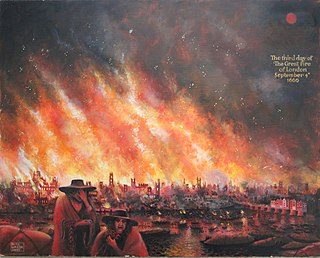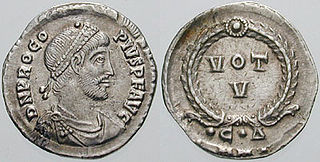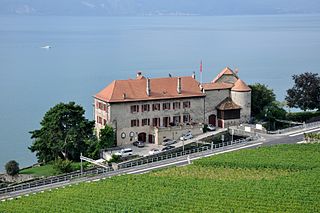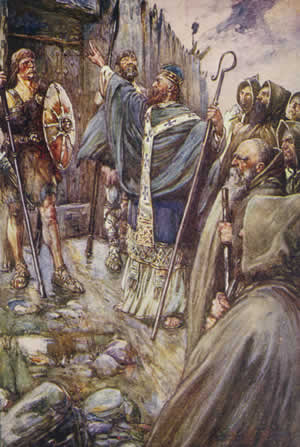
A tsunami is a series of waves in a water body caused by the displacement of a large volume of water, generally in an ocean or a large lake. Earthquakes, volcanic eruptions and underwater explosions above or below water all have the potential to generate a tsunami. Unlike normal ocean waves, which are generated by wind, or tides, which are in turn generated by the gravitational pull of the Moon and the Sun, a tsunami is generated by the displacement of water from a large event.

1609 (MDCIX) was a common year starting on Thursday of the Gregorian calendar and a common year starting on Sunday of the Julian calendar, the 1609th year of the Common Era (CE) and Anno Domini (AD) designations, the 609th year of the 2nd millennium, the 9th year of the 17th century, and the 10th and last year of the 1600s decade. As of the start of 1609, the Gregorian calendar was 10 days ahead of the Julian calendar, which remained in localized use until 1923.
The 560s decade ran from January 1, 560, to December 31, 569.
Year 551 (DLI) was a common year starting on Sunday of the Julian calendar. The denomination 551 for this year has been used since the early medieval period, when the Anno Domini calendar era became the prevalent method in Europe for naming years.

1737 (MDCCXXXVII) was a common year starting on Tuesday of the Gregorian calendar and a common year starting on Saturday of the Julian calendar, the 1737th year of the Common Era (CE) and Anno Domini (AD) designations, the 737th year of the 2nd millennium, the 37th year of the 18th century, and the 8th year of the 1730s decade. As of the start of 1737, the Gregorian calendar was 11 days ahead of the Julian calendar, which remained in localized use until 1923.

1666 (MDCLXVI) was a common year starting on Friday of the Gregorian calendar and a common year starting on Monday of the Julian calendar, the 1666th year of the Common Era (CE) and Anno Domini (AD) designations, the 666th year of the 2nd millennium, the 66th year of the 17th century, and the 7th year of the 1660s decade. As of the start of 1666, the Gregorian calendar was 10 days ahead of the Julian calendar, which remained in localized use until 1923.

Year 685 (DCLXXXV) was a common year starting on Sunday of the Julian calendar. The denomination 685 for this year has been used since the early medieval period, when the Anno Domini calendar era became the prevalent method in Europe for naming years.

Year 697 (DCXCVII) was a common year starting on Monday of the Julian calendar. The denomination 697 for this year has been used since the early medieval period, when the Anno Domini calendar era became the prevalent method in Europe for naming years.

1069 (MLXIX) was a common year starting on Thursday of the Julian calendar, the 1069th year of the Common Era (CE) and Anno Domini (AD) designations, the 69th year of the 2nd millennium and the 11th century, and the 10th and last year of the 1060s decade. As of the start of 1069, the Gregorian calendar was 6 days ahead of the Julian calendar, which was the dominant calendar of the time.

Year 365 (CCCLXV) was a common year starting on Saturday of the Julian calendar. At the time, it was known in the West as the Year of the Consulship of Augustus and Valens. The denomination 365 for this year has been used since the early medieval period, when the Anno Domini calendar era became the prevalent method in Europe for naming years.

Lake Geneva is a deep lake on the north side of the Alps, shared between Switzerland and France. It is one of the largest lakes in Western Europe and the largest on the course of the Rhône. Sixty percent of the lake belongs to Switzerland and forty percent to France.

A megatsunami is a very large wave created by a large, sudden displacement of material into a body of water.

Rikuzentakata is a city located in Iwate Prefecture, Japan. In the census of 2010, the city had a population of 23,302, and a population density of 100 persons per km2. The 2011 Tōhoku earthquake and tsunami caused extensive damage to the city. As of 31 March 2020, the city had an estimated population of 19,062, and a population density of 82 persons per km2 in 7,593 households. The total area of the city is 231.94 square kilometres (89.55 sq mi).

The Bristol Channel floods of 30 January 1607 drowned many people and destroyed a large amount of farmland and livestock during a flood in the Bristol Channel area of the UK. The known tide heights, probable weather, extent and depth of flooding, and coastal flooding elsewhere in the UK on the same day all point to the cause being a storm surge rather than a tsunami.

Niuatoputapu is a volcanic island in the island nation of Tonga, Pacific Ocean. Its highest point is 157 metres (515 ft), and its area is 16 square kilometres (6.2 sq mi). Its name means sacred island. Older names for the island are Traitors Island or Keppel Island.
A tsunami is a series of large water waves caused by the displacement of a large volume within a body of water, often caused by earthquakes, or similar events. This may occur in lakes as well as oceans, presenting threats to both fishermen and shoreside inhabitants. Because they are generated by a near field source region, tsunamis generated in lakes and reservoirs result in a decreased amount of warning time.

The history of Geneva dates from before the Roman occupation in the second century BC. Now the principal French-speaking city of Switzerland, Geneva was an independent city state from the Middle Ages until the end of the 18th century. John Calvin was the Protestant leader of the city in the 16th century.

The Tauredunum event of 563 AD was a tsunami on Lake Geneva, triggered by a massive landslide which caused widespread devastation and loss of life along the lakeshore. According to two contemporary chroniclers, the disaster was caused by the collapse of a mountainside at a place called Tauredunum at the eastern end of Lake Geneva. It caused a great wave to sweep the length of the lake, sweeping away villages on the shoreline and striking the city of Geneva with such force that it washed over the city walls and killed many of the inhabitants.

Glérolles Castle is situated in the municipality of Saint-Saphorin, canton of Vaud, Switzerland, on the northern shore of Lake Geneva. Its earliest elements date from a fortress built around 1150. The modern building serves as the headquarters for a vineyard of the same name, and as a venue which can be hired to host social events. It is a Swiss Cultural Property of Regional Significance.
















